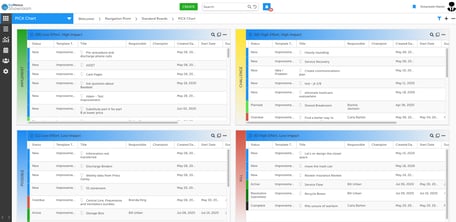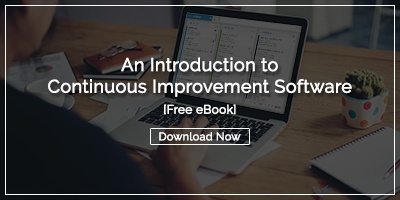 Evaluating software for any purpose is a difficult task. You need to think about the technical infrastructure, user experience, features, implementation, and support. Choosing the right improvement management software comes with its own unique challenges. Most people have never evaluated or even used this type of software before. Another challenge is that many products claim to be fit for this purpose but really aren’t. If you are looking at software to support your continuous improvement efforts, good for you! Here are some questions that will help you frame your evaluation and choose a solution that will be a tremendous asset.
Evaluating software for any purpose is a difficult task. You need to think about the technical infrastructure, user experience, features, implementation, and support. Choosing the right improvement management software comes with its own unique challenges. Most people have never evaluated or even used this type of software before. Another challenge is that many products claim to be fit for this purpose but really aren’t. If you are looking at software to support your continuous improvement efforts, good for you! Here are some questions that will help you frame your evaluation and choose a solution that will be a tremendous asset.
1. Was the software designed to manage improvement work or for some other purpose?
This is a critical question because many vendors with project management or generic collaboration software will try to position it as an improvement management solution. These products typically lack essential features, like impact measurement, that are specific to continuous improvement. These vendors also face competing priorities as they work to satisfy clients who are using the product for different purposes. You’ll be better off if you go with technology designed for improvement work from the ground up.
2. Is the solution available on any device?
Successful organizations take the “continuous” part of continuous improvement literally. Inspired ideas for improvement can happen anywhere, so you want your team to document and act upon them right away. This requires looking for a cloud-based solution that will work on desktops and mobile devices.
3. Does the solution have automated alerts and notifications?
One of the most significant advantages of improvement management software is that it helps keep employees engaged in improvement. The most effective way to do this is to go with a solution that has a built-in workflow to keep everyone aware of tasks and activities. When a due date has passed or progress stalls, managers should be alerted so they can act to ensure the project maintains forward progress.
4. Does the solution have robust search capabilities?
Many people take the ability to search for data for granted, but it is enormously vital for turning your improvement software database into a repository of knowledge for your organization. Users should be able to quickly find past improvement projects to learn from previous challenges and repeat what works best.
5. Can the interface be configured for different users?
Executives, supervisors, team leaders, and front-line employees all have different needs, and approaches to work. Therefore, it is necessary to select an improvement software solution that allows for the configuration of dashboards, reports, and data for each person or role.
6. How does the solution measure the impact of improvement?
The key to sustained quality improvement efforts is the ability to measure impact. When executives and employees can see quantifiable evidence that improvement work produces measurable, positive results, they are likely to make the financial and emotional investments needed to sustain improvement efforts over time. Impact measurement is an essential feature of any improvement software solution that you consider.
7. Can success be broadcast?
Another way to spread the continuous improvement mindset is to make sure to broadcast successes far and wide. The best improvement software tools have built-in broadcasting capabilities, so this type of recognition becomes a standard part of the improvement process.
8. Can leaders quickly gain insight into the health of improvement in the organization?

Besides quantifying the impact of improvement, your improvement management solution should make it easy to understand the level of employee engagement throughout the organization. With the right solution, leaders can see the number of improvement projects in progress, the rate at which opportunities are captured, the employees and teams that are most active in improvement work, and the organization’s progress toward critical goals or milestones.
9. Do you have customers like me?
Improvement software is used by all types of organizations, from manufacturing to financial services. It is a good idea to find out if each solution you consider has customers similar to you in terms of sector, size, and complexity. Ask for references from those customers or at least gain some insight into how other clients are benefiting from the solution.
10. How do you provide implementation assistance and support?
A concrete implementation plan is essential for long-term success and high user adoption. Ask the vendor how they will get you up and going. Will you have a dedicated account manager to walk you through the process? Do they have an effective onboarding methodology? How will long-term customer support be provided? Is there a knowledge repository for self-service help?
If you find an improvement management software provider that has excellent answers to all of these questions, you’ll be able to move forward with confidence and accelerate your path to success.

![[WEBINAR] Bottom-Up Improvement Software Demo](https://no-cache.hubspot.com/cta/default/326641/8545f357-84e1-47b2-81e0-f4fa0d3cd893.png)


Add a Comment